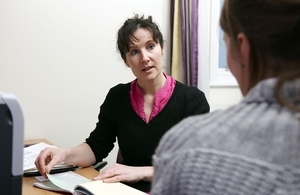Hepatitis C diagnoses rise by a third in England
Laboratory confirmed new diagnoses of hepatitis C infection (HCV) reported in England have risen by more than one-third to 10,873 cases in 2012.

A doctor with a patient
This is up from 7,882 cases in 2010 – when statutory notification by diagnostic laboratories was first introduced.
In London, which accounts for 26% of all hepatitis C cases reported in England in 2012, cases have almost trebled to 2,844 cases in 2012, up from 954 in 2010.
These figures are released today (25 July 2013) in the annual hepatitis C report published by Public Health England (PHE) ahead of World Hepatitis Day on Sunday 28 July.
The report confirms that around 160,000 people are living with chronic hepatitis C virus infection in England – many of whom are unaware of their infection. Across the UK more than 215,000 individuals are thought to be chronically infected.
Over the past 15 years, hospital admissions for hepatitis C-related end stage liver disease and liver cancer in England have increased from 574 in 1998 to 2,266 in 2012, while deaths have risen from 115 in 1998 to 326 in 2012. An increase in registrations for liver transplants has also been observed, with 52 in 1998 to 114 in 2012 – although figures have been relatively stable over the past 5 years.
Hepatitis C is an infectious disease caused by the hepatitis C virus. The virus causes inflammation of the liver, and if left untreated, can result in chronic liver disease, liver failure, or even death. As the liver can still operate even when damaged, many people are unaware they have the disease at first because they have no symptoms. It is often only when the liver becomes seriously damaged that symptoms occur and people report to their doctor.
Dr Helen Harris, a hepatitis expert at PHE, who led the publication of the report, said:
While there has been an increase in confirmed cases of hepatitis C infection, partly as a result of increased testing and partly because of improved laboratory reporting, sadly, many people chronically infected with hepatitis C remain unaware of their infection. For many, it can be several years or even decades before they develop symptoms. It is therefore vital to raise awareness about this condition so that more individuals are diagnosed and treated. Antiviral therapies exist that will clear the virus in most cases, yet only around three per cent of the chronically infected population in England access them each year.
Preliminary results from statistical models presented in the report suggest that numbers of hepatitis C related end stage liver disease and liver cancer patients could be substantially reduced by increasing access to treatment. If the number of people being treated is doubled over the next 10 years, around 6,000 new cases of hepatitis C related end-stage liver disease could be averted over the next 30 years.
In the UK, the greatest risk of hepatitis C infection is through sharing equipment for injecting drugs. Data from the Unlinked Anonymous Monitoring (UAM) survey of people who inject drugs suggest that levels of infection in this group remain high in 2012, with around half of those surveyed in England being infected.
To help reduce the levels of sharing, Needle and Syringe Programmes continue to be developed throughout the UK and latest figures from national surveys of people who inject drugs across the UK suggest that levels of sharing are falling.
Others at risk of hepatitis C include those who have received blood transfusions before September 1991 or blood products before 1986 in the UK. Individuals who originate from countries where hepatitis C is endemic are also at risk, often because they have undergone medical or dental treatment with unsterile equipment in their country of origin.
Dr Paul Cosford, Director for Health Protection and Medical Director at PHE, said:
The first step in getting people treated is to get them tested, so it is good news that more people than ever are being diagnosed. However there is much more that can and should be done to prevent more deaths and serious illness. In particular services need to be more easily accessible to those who need them to ensure better access to effective treatment and potential cure.
We encourage local authorities and NHS colleagues to absorb the recommendations in this report and take local action to drive improvements in the prevention, diagnosis and treatment of hepatitis C infection. PHE is committed to working in partnership with other organisations to tackle this issue now and to help reduce the future burden of hepatitis C-related disease that has been predicted.
Ends
Notes to editors:
- Download the PHE Hepatitis in the UK Report (2013).
- For more information about hepatitis C, please visit PHE’s dedicated pages.
- For information and support, please visit The Hepatitis C Trust website.
- For information about liver disease, please visit the British Liver Trust website.
- Public Health England’s mission is to protect and improve the nation’s health and to address inequalities through working with national and local government, the NHS, industry and the voluntary and community sector. PHE is an operationally autonomous executive agency of the Department of Health.
www.gov.uk/phe Follow us on Twitter @PHE_uk
UKHSA press office: National Infection Service
UKHSA press office, infectious diseases
61 Colindale Avenue
London
NW9 5EQ
Regional press releases
Updates to this page
-
Added regional press release for London
-
First published.